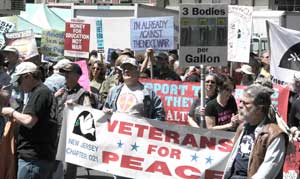More unions, veterans bolster anti-war march
By
Deirdre Griswold
New York
Published May 4, 2006 6:56 PM
|
WW photo: Deirdre Griswold
|
This year’s
anti-war march called by United for Peace and Justice on April 29 saw a larger
than usual participation of unions and military veterans along with the more
familiar faces from peace groups, some of which originated during the Vietnam
War.
The large crowd marched down Broadway from 22nd Street to Foley
Square in lower Manhattan, where organizers had set up tents for a
“grassroots action festival.” It took two and a half hours before
the end of the march had passed its starting point. Organizers estimated the
crowd at 350,000. The corporate media, which projected a neutral tone in its
reporting, gave it tens of thousands.
Notables like Cindy Sheehan, Jesse
Jackson, Susan Sarandon, Daniel Ellsberg and the Rev. Al Sharpton spoke at a
warm-up rally before the march. But the location of the speakers’
platform—a side street—meant that only a small part of the
protesters could hear the talks.
Speeches, banners and slogans focused on
ending the war in Iraq and bringing the troops home; protecting civil liberties
and immigrant rights, rebuilding communities in the U.S., especially the Gulf
Coast; and addressing climate change and the destruction of the
environment.
Many banners and signs also called for no war on Iran. There
were satirical costumes and street theater that mocked the war-mongering of the
Bush administration. One group called for shutting down the U.S. torture center
at Guantanamo as they wheeled a large cage with a hooded man inside guarded by a
person in a U.S. uniform.
Several different veterans’ groups and
military families organized contingents. Iraq war veterans marched in their
uniforms. Some families carried photographs of loved ones killed in the
war.
U.S. Labor Against the War sent delegations from several different
cities. The Pro fessional Staff Con gress, the Transport Work ers Union, UNITE
HERE, 1199-SEIU and other public sector unions drew attention to the siphoning
off of tax money from social programs to pay for the occupation of Iraq and
Afghanistan, with slogans like “Health care, not warfare” and
“Health care and education, not war and occupation.”
The
delegations of service workers had the most people of color, although some
Black, Latin@, Middle Eastern and Asian people were dispersed through the large
demonstration.
Many marchers carried signs identifying themselves as
coming from New England, Long Island, Westchester and other areas outside the
city. Their slogans often expressed dismay at being betrayed by the government
and longing for what they believed to have been a more democratic
era.
While some signs threatened to vote out the Republicans, there was
clearly disappointment among many who have voted Democratic that even the
significant popular swing against the war and the administration has failed to
produce any strong anti-war voice in the so-called “opposition”
party.
Articles copyright 1995-2012 Workers World.
Verbatim copying and distribution of this entire article is permitted in any medium without royalty provided this notice is preserved.
Workers World, 55 W. 17 St., NY, NY 10011
Email:
[email protected]
Subscribe
[email protected]
Support independent news
DONATE


